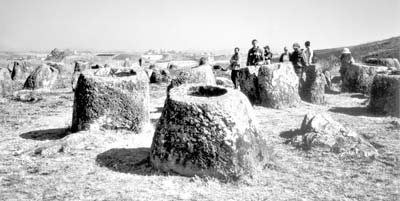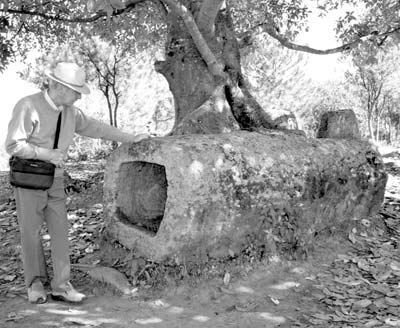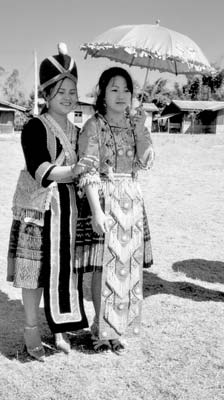The Plain of Jars in Laos
I stood on a hill overlooking a wintry landscape of dry fields stretching as far as the eye could see. All around me were stone jars. Enormous stone jars. Some stood six feet high. Some were no longer upright but tilted precariously. Others lay flat on the ground. My husband, Paul, moved from one jar to the next, standing on tiptoe to peer inside, hoping to discover. . . bones, ashes, undiscovered treasure?
Kham, our guide, told us, “This is called the Hill of Big Jars. As you can see, there are lots of big stone jars all around, but these, here on this hill, are among the largest.”
We were in northern Laos, about 90 miles southeast of the UNESCO World Heritage Site city of Luang Prabang, in an area called — appropriately — the Plain of Jars. In a wide swath around the provincial capital of Phonesavanh lie an estimated 60 stone jar sites. A few of these sites have only one jar. Some, like the site where we were standing, Site One, have hundreds.
We narrowed our exploration of the Plain of Jars to the three main stone jar sites because of time limitations but more importantly because these three sites are the only ones that have been declared safe for visitors. The other sites are still off limits because of UXO, or unexploded bombs, shells and land mines — the sad legacy of decades of war.
Sites One, Two and Three are “clean,” but we were still careful to follow in Kham’s footsteps as he led us down a narrow pathway to the foot of the hill where more huge jars literally littered the ground.
We wandered among these jars feeling small beside them. The jars, carved from boulders of either a sandstone-like material (most) or granite (a few), weighed between half a ton and a ton, although Kham said there was one jar that weighed six tons. Here and there, a few stone covers lay on the ground that must once have served as lids to these jars.
What were these jars used for? Theories abound. Perhaps for rice storage or wine fermentation. There is even an extraterrestrial explanation: giants from outer space used these jars as drinking vessels.
Most likely, these stone jars were either sarcophagi containing bodies or ashes, parts of ancient cemeteries, or they might have been memorial monuments honoring either a deceased individual or the deceased of an entire family, similar to stones or markers placed over graves nowadays. Future archaeological investigations may supply some answers.
Site Two
Site One (Thong Hai Hin), the first site we visited, is about 10 miles west of Phonesavanh. It was another 12 miles to Site Two (Hai Hin Phu Salato). Hai hin in Lao means “stone jar.”
At Site Two, steep steps lead to the first of twin wooded hilltops with stone jars similar to those at Site One. One difference is that most of the stone jar lids found at Site One were once placed directly atop the jars, whereas many of the lids at Site Two were carved so that they could fit just inside the neck of the stone jars.
A short scramble downhill and a brief hike up, the adjoining hilltop has jars scattered among trees, some of which rooted themselves as saplings inside the jars and have now — with the passage of time — split the stone jars apart.
Visiting Site Three (Hai Hin Lat Khai), 10 miles beyond Site Two, is a bit more of an adventure. It involves a hike along a rickety wood-plank bridge across a shallow stream and a 15-minute trek along narrow pathways among the rice paddies to a wooded mound with dozens of jars.
Another question to Kham — ‘How old are all these jars?’
He told us that the best guess is 2,000 to 3,500 years old. Once again, future archaeological research might come up with more precise dates, especially if bones or ashes are found.
Sites One, Two and Three contain between 500 and 700 stone jars depending on which estimate you accept. Fragments of jars are sometimes not counted. The Plain of Jars is scheduled to be included on the prestigious UNESCO list of World Heritage Sites within the next few years. In preparation, other jar sites are being cleared of UXO, opening the door for archaeologists and, perhaps, more answers regarding who carved the jars and when and why.
Laos highlights
Our visit to the Plain of Jars was part of a 15-day trip to Laos that included a sampling of the best this relatively unknown, touristically uncrowded country has to offer. Frankly, we hadn’t expected much but were rewarded with one of the best trips we’ve ever taken.
Just a few of the highlights — in Vientiane, Laos’ capital, there are golden That Luang, a stupa built by a king in 1566; Wat Sisaket, a Buddhist monastery housing almost 7,000 Buddha statues, and French restaurants equaling those we’ve enjoyed in Paris.
In Luang Prabang, we visited some of the most beautiful temple complexes we’ve seen, including Wat Xieng Thong, with glass mosaics decorating some of its chapels; the addictive night market (out of five nights in Luang Prabang, we went to the night market four times); the Pak Ou caves beside the Mekong River, filled with small Buddha statues, and a makkhon, a traditional dating ceremony with young girls in gorgeous costumes.
In Pakse, in the far south of Laos, there are numerous waterfalls and the Khmer ruins at Champassak, another UNESCO World Heritage Site.
On Khong Island, even farther south, close to the Thai and Cambodian borders, fishing villages abound and boat trips on the Mekong River are available.
And, of course, outside Phonsevanh is the Plain of Jars.
Throughout Laos, we visited colorful, bustling local markets — always a joy for photography and people-watching.
If you go. . .
Our customized 15-night private tour of Laos was arranged by Diethelm Travel (Setthathirath Road, Namphu Square, Vientiane, Lao P.D.R.; phone 856-21-213-833, fax 856-21-217-151, e-mail dtlls@ diethelmlaos.com or ditralao@aotel. com or visit www.diethelmtravel. com), a company with lots of experience in Southeast Asian travel. We’ve traveled with Diethelm before in Thailand.
Diethelm did a superb job on this Laos trip — excellent guides, good vehicles and comfortable hotels, including three superb A+ hotels we stayed in for nine nights out of our 15 nights in Laos: the serene new Green Park Boutique Hotel in Vientiane; the venerable, traditional Settha Palace Hotel, also in Vientiane, and the luxurious Grand Luang Prabang Hotel, just outside Luang Prabang, surrounded by gardens and reflecting pools. All are beautiful properties loaded with personality and charm.
For our customized trip for two, we paid $3,390, including hotels, breakfasts, tours, admissions, car, driver, guide and internal air.
Final words — go to Laos as soon as you can, before everyone else does.
—Focus on Archaeology is written by Julie Skurdenis.



